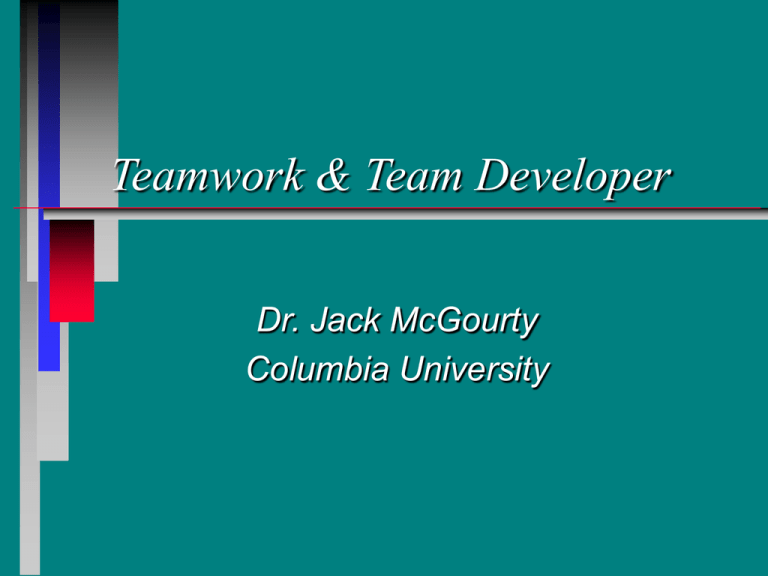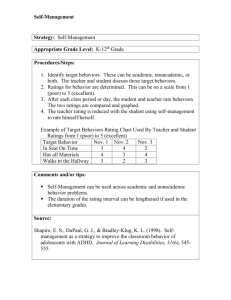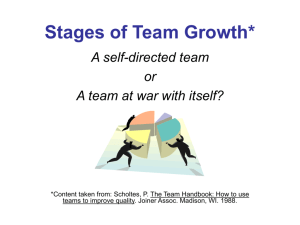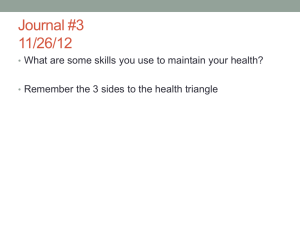Teamwork & Team Developer Dr. Jack McGourty Columbia University
advertisement

Teamwork & Team Developer Dr. Jack McGourty Columbia University Why Teams? Respond to multi-functional challenges Enhance communication Bring together complementary skills and experiences Respond to change with swiftness and flexibility Provide unique social dimension Have more fun! Team-Based Organizations Common Objectives • • • • • • Flexibility Speed Customer focus Continuous improvement Innovation Balance between process and people Stages of Team Development Forming Challenging Accepting Collaborating Self-Managing Forming Common behaviors • attempts to define tasks • determining acceptable behavior • floundering as to where to begin • dependence on leader • unequal participation • diving into “solutions” • everyone is “polite” Common feelings • • • • • anticipation confusion anxiety impatience fear Challenging Common behaviors • arguing among members • defensive & competitive • establishing unrealistic goals • questioning credibility of leader/members • choosing sides • passing the blame • not so “polite” Common feelings • • • • • • resistant rebellious defensive angry suspicious jealous Accepting Common behaviors • attempts to achieve harmony by avoiding conflict • expressing opinions more openly • sharing of information • less resistance to team tasks • learning the best way to work together Common feelings • • • • • “we-ness” cooperative enthusiasm relief tentative Collaborating Common behaviors • balanced contributions • focused on goals & results • solving problems collectively • able to reach consensus & closure • encouraging criticism & conflict • sharing accountability Common feelings • • • • • satisfaction energetic motivated close affiliation confident in each other’s abilities • invulnerable Self-Managing Common behaviors • pushing for higher standards • following through on commitments • challenging the way things are normally done • stressing continuous improvement • meeting only when necessary Common feelings • increasingly motivated • sense of self-fulfillment • excitement about new challenges • fear of adjournment Team Performance Model How do you accelerate team effectiveness? Forming—Skills Communication • proactively listens • conveys interest • restates to show understanding Self-Management • identifies purpose & goals • defines priorities • suggests ways to proceed Decision-Making • solicits participation from other members • discourages rushing to conclusions Collaboration • reinforces contributions of others • encourages opposing ideas & opinions Challenging—Skills Communication • articulates ideas clearly • clarifies to ensure understanding Self- Management • clarifies roles & responsibilities • creates action plans & timetables Decision Making • suggests new approaches to solving problems • accepts change Collaboration • helps reconcile differences of opinions • accepts criticism openly Accepting—Skills Communication • gives compelling reasons for ideas • wins support from others Self-Management • monitors progress • places top priority on getting results Decision making • generates new ideas • solicits information from “outside” the team Collaboration • involves others in decisions that affect them • frequently polls others for opinions Collaborating—Skills Communication • shares information openly • encourages communication with people outside the team Self-Management • reviews team process frequently • focuses on building required skills Decision Making • challenges the status quo • plays “devil’s advocate” Collaboration • shares accountability • works towards “win/win” solutions Self-Managing—Skills Communication • provides continuous feedback to team • proactively communicates across the organization Self-Management • pushes for higher standards • stresses continuous improvement Decision Making • focuses on creativity & innovation • anticipates problems & develops contingency plans Collaboration • resolves external issues/barriers affecting performance Ways for Team Members to Foster Team Effectiveness Share all relevant information willingly Disagree openly with team members Invite questions/comments Avoid cheap shots and other distractions Expect all team members to participate Make decisions by consensus Conduct self- and teamcritiques Others? Ways for the Team Leader to Foster Team Effectiveness Create conducive team culture Ask for solutions rather than problems Facilitate problemsolving and brainstorming Support and reward team behaviors Address counterproductive team behaviors Rotate leadership role of team meetings Be a resource to teams and a role model Others? Critical Success Factors Specific & challenging goals Clarified roles and responsibilities Complementary skills Dynamic working agreement Shared accountability Supportive external environment Team Developer Description and Process Team Developer Computerized survey for multi-source assessment and feedback Competency-based: basic team skills and other engineering-related learning outcomes Self/peer ratings as to frequency in which learning outcomes are observed Provides individual/team/class feedback Team Developer Screen Survey Process Instructor establishes student teams Creates survey questions; typically 40 plus items Best practice is to provide students with an understanding of learning outcomes in general, and Team Developer Process prior to administration Administer 2x per semester; after 3-4 weeks of team interaction and at the end of the project Reports distributed after administration Work with students on action plans for improvement Survey Administration Individual student disks Short period of time to complete Reports distributed confidentially Instructor debriefs class Multiple administrations per semester recommended Feedback Reports Students • individualized report showing comparisons between self-ratings and aggregate team member ratings • improvement between interim & final Faculty • aggregate data for teams • comparison by section/class Student Report ITEM RATINGS BY DIMENSION COMMUNICATION Helping to sustain and environment where people feel free to speak candidly, articulating ideas clearly and concisely, listening and demonstrating an understanding of other’s perspectives. Active Listener Listens attentively to other team members without interrupting Conveys interest in what others are saying Provides others with constructive feedback Restates what has been said to show understanding Clarifies what others have said to ensure understanding Self Team 3.8 4.0 5.0 4.0 3.0 3.0 3.8 4.1 3.3 4.1 3.7 3.4 Report Highlights Compares self rating to team’s average rating for individual Compares ratings from past performance when available Summary & detail item level results Developmental suggestions Action planning guide Understanding Results Read feedback as a “snapshot” Compare self- ratings to team-ratings Compare present ratings with past Work from summary level to item details What is Feedback? Information that lets team members know whether they are on target in relation to a specific goal or behavior Using Results for Individual Development Seek clarification from others Review developmental suggestions Explore additional developmental activities Develop action plans Set realistic goals Solicit continuous feedback Using Results for Team Development Conduct process discussions Develop working agreements Monitor team’s progress Providing Feedback Focus on issues and behaviors, not person Avoid being general Give specific examples of behavior and incidents Give feedback in a timely manner Demonstrate relationship between behavior/team objectives Provide positive information first Define expectations in advance Involve recipient in developing solutions Receiving Feedback Accept feedback as "reality" for provider Restate to provider what you think has been said Probe for additional information Focus on how it can help solve a specific Problem Regularly solicit feedback Benefits Self/Peer Assessment Students motivated to decrease gaps between self-assessment and peer evaluation Significant increase in skills and behaviors precipitated by peer feedback Reinforces criticality of competencies Prepares for industry assessment practices Develops self/peer critical evaluation skills for life long learning Team Developer Questions and Next Steps



